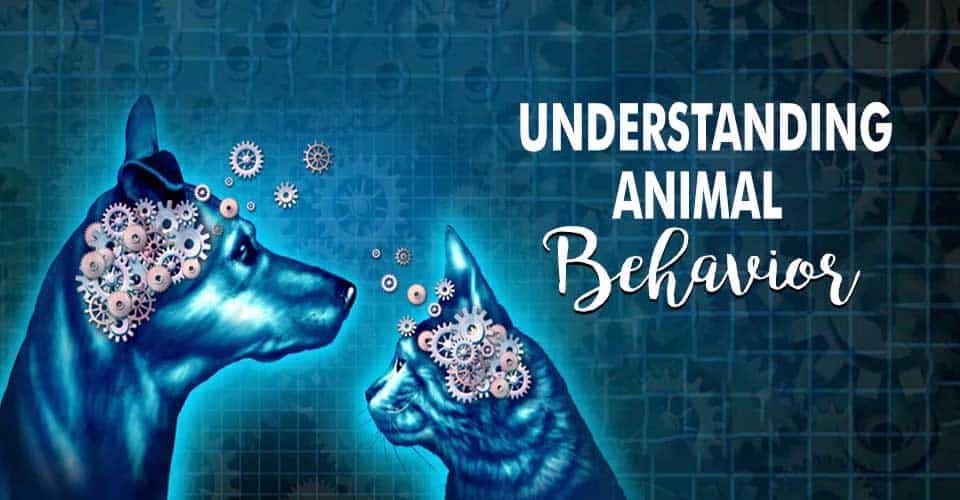Animal behavior is the study of how animals interact with their environment and exhibit specific patterns of actions and responses. By understanding and appreciating the human-animal bond, individuals can develop a greater sense of empathy, which has been linked to improved quality of life and overall well-being.
What is Animal Behavior?
Animal behavior is conceptually defined as 1 Houpt K. A. (1991). Animal behavior and animal welfare. Journal of the American Veterinary Medical Association, 198(8), 1355–1360. the observable actions, reactions, and patterns of activity exhibited by animals in response to internal and external stimuli.
Animal behavior is studied across various species and environments, aiming to understand the underlying factors such as the role of genetics, the impact of learning and conditioning, the influence of social dynamics and hierarchies, as well as the effects of environmental variables on behavior.
Numerous studies have demonstrated the benefits of interaction with animals which can reduce stress, lower blood pressure, and improve mood. Therefore, Pet therapy 2 Hajar, R. (2015). Animal-assisted therapy. Heart Views, 16(2), 70. https://doi.org/10.4103/1995-705x.159228 programs are implemented in healthcare settings, schools, and community organizations, harnessing the power of the human-animal bond to enhance mental well-being and improve quality of life.
Examples of Animal Behavior
Here are a few noteworthy behaviors exhibited by animals:
- Blinking- as a protective reflex to keep their eyes moist, clear away debris, and shield them from potential harm.
- Eating- to consume nutrients and energy required for their survival, growth, and bodily functions.
- Walking- to navigate their environment and reach food, water, or shelter.
- Flying- to travel efficiently through the air to search for food, migrate, or escape predators.
- Vocalizing- such as calls, songs, or roars, to communicate for purposes such as territorial defense, attracting mates, or warning others of danger.
- Huddling- where individuals group together 3 Sukhchuluun, G., Zhang, X. Y., Chi, Q. S., & Wang, D. H. (2018). Huddling Conserves Energy, Decreases Core Body Temperature, but Increases Activity in Brandt’s Voles (Lasiopodomys brandtii). Frontiers in physiology, 9, 563. https://doi.org/10.3389/fphys.2018.00563 closely to share body heat, provide protection, or enhance social bonds.
- Avoiding Predators- by behaviors like camouflage, mimicry, alarm calls, or fleeing, to reduce the risk of predation and ensure their survival.
- Reproduction- ensuring successful fertilization, and maximizing offspring survival.
- Choosing Mates- engaging in competitive behaviors, or assessing the quality of potential partners, to increase reproductive success and genetic fitness.
What is the Bond Between Humans and Animals
The human-animal bond 4 Wensley S. P. (2008). Animal welfare and the human-animal bond: considerations for veterinary faculty, students, and practitioners. Journal of veterinary medical education, 35(4), 532–539. https://doi.org/10.3138/jvme.35.4.532 is a unique and multifaceted connection that spans cultures, societies, and history. This bond is characterized by mutual benefits, as animals offer companionship, unconditional love and emotional support, positively impacting human mental well-being, while humans provide care, shelter, and nourishment, ensuring the physical health and well-being of animals.
Humans and animals frequently partake in shared experiences and activities, engaging in playful interactions, exercising together, and exploring the world side by side. These joint endeavors cultivate feelings of joy, adventure, and a deep sense of connection, ultimately strengthening the bond between humans and animals.
How Animals Help Our Mental Health
Keeping pets for mental health 5 Beetz, A., Uvnäs-Moberg, K., Julius, H., & Kotrschal, K. (2012). Psychosocial and psychophysiological effects of human-animal interactions: the possible role of oxytocin. Frontiers in psychology, 3, 234. https://doi.org/10.3389/fpsyg.2012.00234 and well-being of human beings has several positive effects such as:
- Pets provide companionship which helps humans to build a connection and enhance reciprocating interaction between humans and animals.
- The unconditional love of both pets and humans promotes emotional communication and mutual responses between them.
- Having a pet allows for the development of long-term attachments, providing a sense of emotional security, bonding, comfort, and a consistent source of support.
- Interacting with pets cultivates empathy and caring for animals helps individuals develop an understanding of both their needs and emotions.
- Keeping pets involves exchanging non-verbal messages and body language mutually, which enables a better understanding of both of their behaviors.
Read More About Pet Therapy Here
How to Make Friends with Animals?
Developing a bond and making friends 6 Wood, L., Martin, K., Christian, H., Nathan, A., Lauritsen, C., Houghton, S., Kawachi, I., & McCune, S. (2015). The pet factor–companion animals as a conduit for getting to know people, friendship formation and social support. PloS one, 10(4), e0122085. https://doi.org/10.1371/journal.pone.0122085 with animals can be a fulfilling experience. Here are some improved tips to help you along the way:
- When meeting a new animal, approach them calmly and respectfully, allowing them space and time to assess your presence and establish comfort.
- Offer treats, praise, or gentle petting as a reward when the animal displays calm and friendly behavior.
- Take the time to learn the animal’s signals and body language, enabling you to better understand their comfort level and boundaries.
- Spend regular, consistent time with the animal to build familiarity and trust, engaging in activities they enjoy and creating shared experiences.
- Try to avoid using violent actions or harsh language to communicate with your pet.
- Respect your pet’s likes and dislikes, recognizing and honoring their individual preferences regarding touch, play, and social interaction.
- Try to approach your interactions with empathy, considering your pet’s needs, emotions, and physical well-being.
- Engage in positive reinforcement-based training to teach your pet new things, providing mental stimulation and opportunities for growth.
- Ensure your pet is not left alone for long periods of time, as animals thrive on companionship.
Takeaway
Understanding animal behavior helps people to appreciate the unique qualities and needs of pets, enabling individuals to foster meaningful connections with them. Keeping pets for mental health provides people comfort, companionship, and a source of happiness that ultimately linked with the overall quality of life.
Frequently Asked Questions (FAQs)
1. Why are humans so attached to animals?
Humans form strong attachments to animals due to the emotional connection, companionship, and therapeutic benefits they provide, contributing to improved well-being and a sense of fulfillment.
2. Can animal behavior change over time?
Environmental changes, such as alterations in habitat or availability of resources, can influence animal behavior patterns.
3. What is Pet therapy?
Pet therapy, also known as animal-assisted therapy, is a structured and purposeful interaction between an individual and a specially trained animal, aimed at enhancing overall health, fostering emotional connection, and facilitating a sense of comfort and relaxation.











